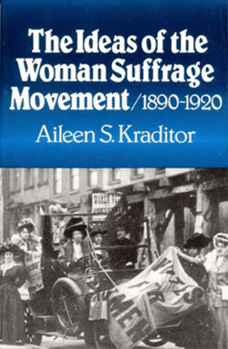The Ideas of the Woman Suffrage Movement: 1890-1920
Select Format
Select Condition 
Book Overview
What united and moved millions of women to seek a right that their society denied them? What were their beliefs about the nature of the home, marriage, sex, politics, religion, immigrants, blacks,... This description may be from another edition of this product.
Format:Paperback
Language:English
ISBN:0393000397
ISBN13:9780393000399
Release Date:April 1981
Publisher:W. W. Norton & Company
Length:336 Pages
Weight:0.60 lbs.
Dimensions:0.9" x 4.9" x 7.4"
Customer Reviews
2 ratings
A long struggle
Published by Thriftbooks.com User , 15 years ago
Kraditor underscores two fundamental facts of the suffrage movement. First, women strove for gender equality over an extended period of time and secondly, during the course of the struggle the nation changed dramatically. To achieve suffrage women adapted their ideas and arguments to the conditions. For both the nation and for women it was an evolutionary process. What had begun as an idealized democratic vision of justice and equality was out of necessity denigrated to the expediency of political compromise. The fight for the ballot was won, not completely from the guarantees afforded by the Constitution and Bill of Rights, but from the alliance of diverse interests in pursuit of compatible political agendas. During this protracted period, the country was transformed from a predominantly rural society and economy into an urbanized industrialized nation. Paralleling this profound metamorphous, the suffragist strategy evolved concomitantly from the pursuit of "natural rights to expediency" as a means for women to win the vote. The struggle for women's suffrage spanned a period of seventy years. In 1848 women first met in Seneca Falls, New York and drew up the "Declaration of Sentiments" that included a controversial demand for women's right to vote. However it was the opposition to slavery that gave roots to the suffrage movement. "The founders of the women's movement were all abolitionists, although not all abolitionists believed in equal rights for women."(1) This dichotomy created a problem. "One who studies the women pioneers for women's rights in the United States cannot easily decide at all times whether the desire for their own emancipation or for the desire for the emancipation of the slave motivated them more strongly." (2) Throughout its history the movement was never completely in accord. Not all women agreed with the goal of women's suffrage and not all leaders of the suffrage movement always agreed on policy and strategy. Undoubtedly this is one of the reasons the struggle took so long. The United States of 1848 was a very different country from the United States of 1920 when the Nineteenth Amendment was ratified. The development of factories, the growth of cities and changes in society dramatically transformed the country. In pre-industrial America, home and work places were shared. Some specialized shops permitted workers to congregate and share tools but products were still custom built. In time workshops became powered from a central plant, but specialized factories had not yet developed. As industrialization progressed the bringing together of machinery and labor in new factories increased the efficiency of production. The concentration of capital in industry and profits that accrued to the benefit of a few wealthy industrialists, such as Carnegie, did not help the majority of workers. As a result of industrialization there was crowding and poverty in urban areas as people came to the cities to work. It was the social implic
Foundational Text
Published by Thriftbooks.com User , 22 years ago
For scholars of the women's suffrage movement, this book by Kraditor remains a central text. Although her politics appear to influece her analysis and her focus is on the East Coast, her work is solid, influential, and a wonderful jumping off point for anyone studying the different strains of thought in the suffrage movement.





